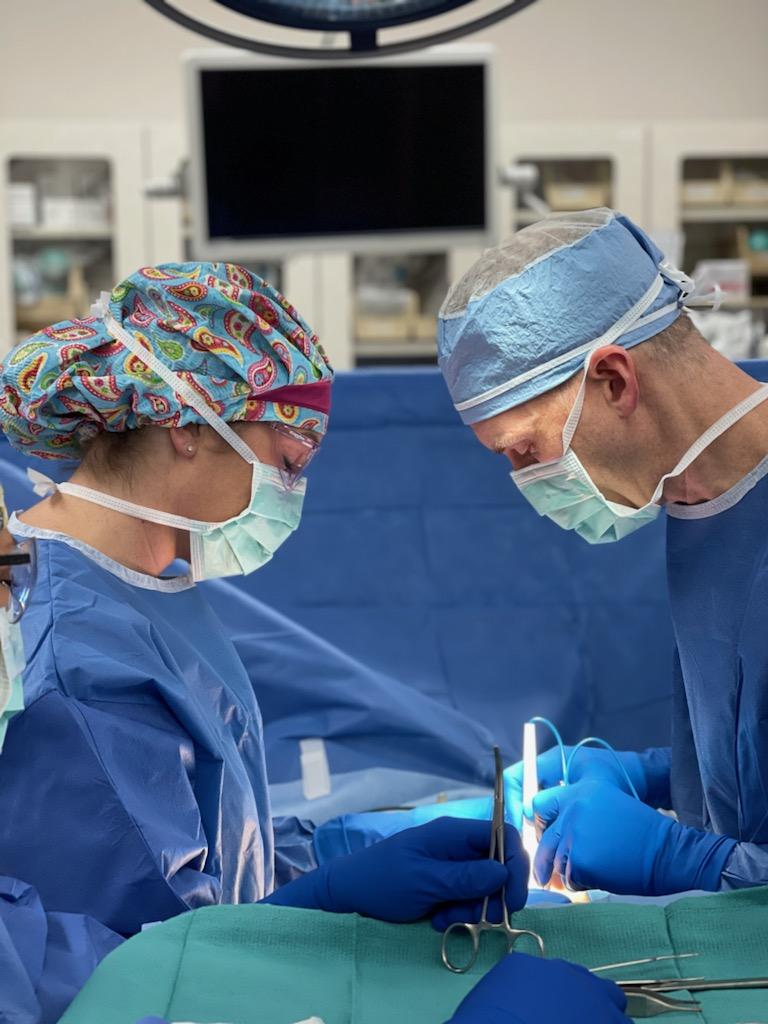Hernia Surgery
A hernia is a bulge or protrusion of tissue through the abdominal musculature. About 10% of people develop a hernia in their lifetime. They are classified by location or etiology. Hernias occur secondary to loss of mechanical integrity of the abdominal muscles. Once a hernia forms, it will continue to increase in size due to the increase in wall tension at that location. Many times, hernias do not cause any significant symptoms. Occasionally they will cause abdominal pain or a dull ache. Most patients present with a bulge or asymmetry to the abdominal wall.
The most common types of hernias are listed below:
Epigastric – midline hernia between the umbilicus and breastbone
Umbilical – midline hernia centered at the umbilicus
Inguinal – hernia located low in the groin, either left or right
Femoral – hernia located at the top of the thigh, just below the groin crease, either left or right
Incisional – hernia from prior surgery, typically located directly underneath prior scar or incision
How do I know if I have a hernia?
To determine if you have a hernia, we recommend an examination by a trained surgeon. Most times, this avoids additional testing such as CT scan, ultrasounds, or MRIs. If the diagnosis is unclear, an imaging study may be ordered to help with the diagnosis.
Once a hernia has been established, most people will ultimately have these repaired. It is rare for hernias to be repaired emergently. This occurs when bowel or intestine become pinched off by passing through the hernia defect. Most are scheduled at your convenience when you can take time off work and can limit your activities after surgery.
How is a hernia repaired?
Hernia repairs can be done laparoscopically or through an open incision. A small superficial hernia can be repaired with a small open incision with little downtime and pain. For inguinal hernias, there is clearly a benefit to having this surgery performed laparoscopically. This leads to less pain and quicker return to normal activities. For other hernias such as larger umbilical or incisional hernias, laparoscopic repair has similar benefits of less pain and earlier return to normal activities. For most laparoscopic repairs, the defect in the abdominal wall is repaired with a specially designed mesh. This is a safe mesh made of polypropylene and has been used in hernia repairs since the 1960s. The mesh serves as a scaffold for which the defect closes. Many open hernias will also need mesh placement due the size of the defect and the expected tension on the muscle repair.
Most hernia surgeries take less than one hour and can be done on an outpatient basis at a surgery center or hospital outpatient surgery department.
What will my recovery be like?
Following surgery, patients are discharged to home. Routine discharge instructions are sent home providing instructions for wound care, diet, activity and medication instructions. Pain medications are electronically prescribed to your pharmacy. Usually, patients have a mild degree of pain for the first few days and resolves completely in the first 1-2 weeks. Patients usually take a few days off from work to recover from surgery. Dr. Biggs will see you back in the office about 2 weeks after surgery to make sure you have fully recovered from your surgery.

” Once a hernia forms, it will continue to increase in size due to the increase in the wall tension at that location.“
Kind words from our patients
“Everyone was great, very helpful and courteous!! Would recommend Dr Biggs. Appreciate his straight forwardness!!”
– Jan
Contact Us
Office
Dr Rodney Biggs MD
530 Running W Dr Ste 120
Gillette, WY 82718
Office Hours
Mon-Thu: 8:30am – 4:30pm
Fri: 8:30am – 12:00pm
Sat & Sun: Closed
